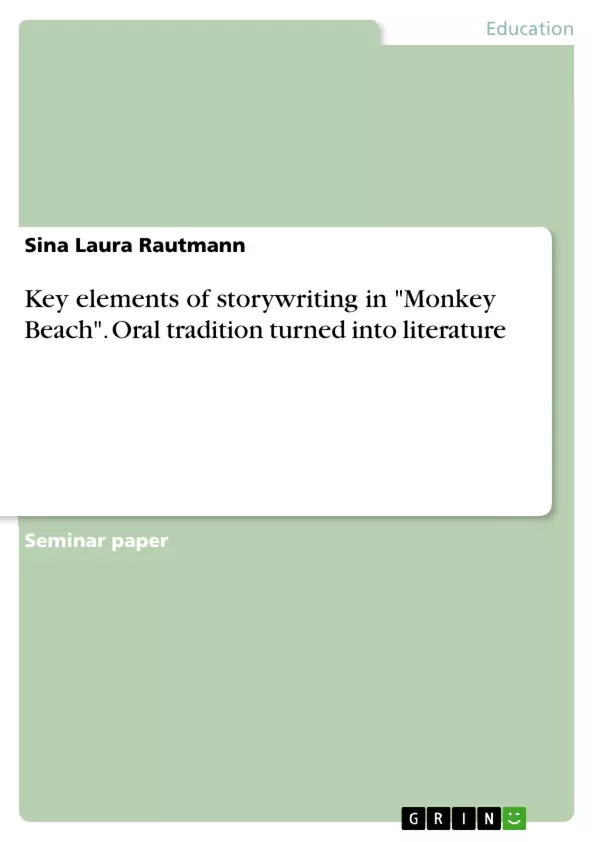Only very few people are used to storytelling for even fairy tales are written down and read out loud to children the same way over and over again without alteration.
Changing perspective to first nation tribes one can easily discover the importance that oral tradition and storytelling has to these people. It existed long before literature was introduced by the settlers in the post-colonial era. While contemporary Canadian fiction and short story writing developed in the middle of the nineteen-hundredth century, Native Canadian Writing was forced to create their own distinctive style of writing. By combining storytelling with literature the new genre of storywriting was created.
In this paper I will analyze the key features of storywriting and will exemplify them with quotes from the book Monkey Beach by Eden Robinson (2000). First I will present a short overview over the author and the book in general. Then I will give a brief overview about the main motifs, symbols and topics that the book deals with. In the main part of this paper I will present different quotes and show typical aspects for oral tradition that can be found within them.
Table of Contents
- Introduction
- About the Author and the Book
- Eden Robinson
- Monkey Beach
- Main Topics and Motifs covered in the Book
- Storywriting – Oral Tradition as a Written Style
- Explicit and Implicit Stories of the Past (Legends/Lore)
- The Meaning of Names
- Wisdom, Teachings and Traditions passed on to the Younger Generation
- Conclusion
- Works Cited and Additional Resources
Objectives and Key Themes
This paper analyzes the key features of storywriting and exemplifies them with quotes from the book Monkey Beach by Eden Robinson (2000). The paper explores the significance of oral tradition and storytelling in contemporary Canadian Indigenous writing, particularly within the context of the Haisla culture.
- The blending of oral tradition and written literature in contemporary Indigenous writing.
- The role of storytelling in preserving and transmitting cultural knowledge and traditions.
- The impact of colonialism and residential schools on Indigenous communities and individuals.
- The themes of loss, trauma, and healing in relation to cultural identity.
- The exploration of Indigenous mythology, folklore, and spiritual beliefs.
Chapter Summaries
The paper begins with an introduction that sets the stage for the discussion of oral tradition in contemporary Canadian literature. It highlights the importance of storytelling within Indigenous cultures and discusses the unique style of storywriting that emerged as a result of colonization.
Chapter 2 provides a brief overview of Eden Robinson and her novel Monkey Beach. It explores the author's background, the themes and motifs covered in the book, and the significance of the title.
Chapter 3 delves into the specific elements of storywriting, focusing on the ways in which oral tradition is integrated into the written text. It examines the use of legends, lore, and naming conventions within the narrative, as well as the importance of passing down wisdom and traditions to younger generations.
The paper concludes with a chapter that summarizes the findings and reinforces the importance of understanding the role of oral tradition in shaping contemporary Indigenous literature.
Keywords
The key terms and concepts explored in this paper include: oral tradition, storywriting, contemporary Canadian Indigenous literature, Haisla culture, colonialism, residential schools, Indigenous mythology, folklore, and cultural identity.
- Quote paper
- B.A. Sina Laura Rautmann (Author), 2016, Key elements of storywriting in "Monkey Beach". Oral tradition turned into literature, Munich, GRIN Verlag, https://www.grin.com/document/370038



